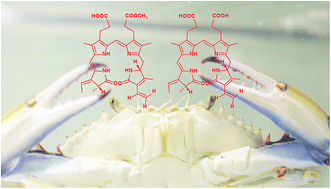当前位置:
X-MOL 学术
›
Nat. Prod. Rep.
›
论文详情
Our official English website, www.x-mol.net, welcomes your feedback! (Note: you will need to create a separate account there.)
Finding food: how marine invertebrates use chemical cues to track and select food
Natural Product Reports ( IF 11.9 ) Pub Date : 2017-02-20 00:00:00 , DOI: 10.1039/c6np00121a Michiya Kamio 1, 2, 3 , Charles D. Derby 4, 5, 6, 7
Natural Product Reports ( IF 11.9 ) Pub Date : 2017-02-20 00:00:00 , DOI: 10.1039/c6np00121a Michiya Kamio 1, 2, 3 , Charles D. Derby 4, 5, 6, 7
Affiliation

|
Benthic marine invertebrates sense molecules from other organisms and use these molecules to find and evaluate the organisms as sources of food. These processes depend on the detection and discrimination of molecules carried in sea water around and in the mouths of these animals. To understand these processes, researchers have studied how molecules released from food distribute in the sea water as a plume, how animals respond to the plume, the molecular identity of the attractants in the plume, the effect of turbulence on food-searching success, and how animals evaluate the quality of food and make decisions to eat or not. This review covers recent progress on this topic involving interdisciplinary studies of natural products chemistry, fluid dynamics, neuroethology, and ecology.
中文翻译:

寻找食物:海洋无脊椎动物如何使用化学线索来跟踪和选择食物
底栖海洋无脊椎动物感知来自其他生物的分子,并利用这些分子来发现和评估这些生物作为食物的来源。这些过程取决于对这些动物周围和口腔中海水中所携带分子的检测和区分。为了理解这些过程,研究人员研究了从食物中释放的分子如何作为羽状物质在海水中分布,动物如何对羽状物质做出反应,羽状物质中引诱剂的分子特性,湍流对寻找食物成功的影响以及动物如何评估食物的质量以及如何决定是否进食。这篇综述涵盖了该主题的最新进展,涉及天然产物化学,流体动力学,神经行为学和生态学的跨学科研究。
更新日期:2017-05-04
中文翻译:

寻找食物:海洋无脊椎动物如何使用化学线索来跟踪和选择食物
底栖海洋无脊椎动物感知来自其他生物的分子,并利用这些分子来发现和评估这些生物作为食物的来源。这些过程取决于对这些动物周围和口腔中海水中所携带分子的检测和区分。为了理解这些过程,研究人员研究了从食物中释放的分子如何作为羽状物质在海水中分布,动物如何对羽状物质做出反应,羽状物质中引诱剂的分子特性,湍流对寻找食物成功的影响以及动物如何评估食物的质量以及如何决定是否进食。这篇综述涵盖了该主题的最新进展,涉及天然产物化学,流体动力学,神经行为学和生态学的跨学科研究。

























 京公网安备 11010802027423号
京公网安备 11010802027423号